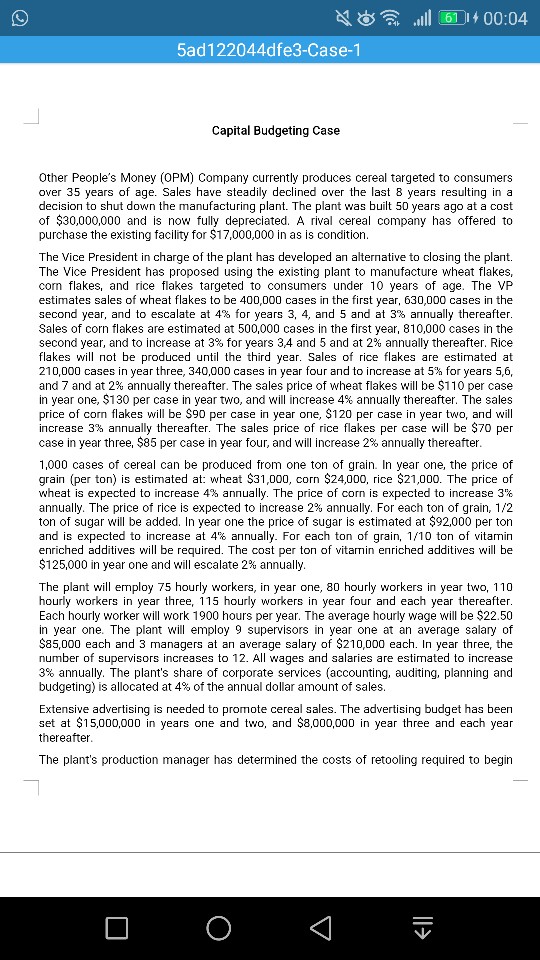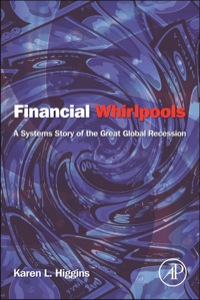Answered step by step
Verified Expert Solution
Question
1 Approved Answer
5ad122044dfe3-Case-1 Capital Budgeting Case Other People's Money (OPM) Company currently produces cereal targeted to consumers over 35 years of age. Sales have steadily declined over

5ad122044dfe3-Case-1 Capital Budgeting Case Other People's Money (OPM) Company currently produces cereal targeted to consumers over 35 years of age. Sales have steadily declined over the last 8 years resulting in a decision to shut down the manufacturing plant. The plant was built 50 years ago at a cost of $30,000,000 and is now fully depreciated. A rival cereal company has offered to purchase the existing facility for $17,000,000 in as is condition The Vice President in charge of the plant has developed an alternative to closing the plant. The Vice President has proposed using the existing plant to manufacture wheat flakes, com flakes, and rice flakes targeted to consumers under 10 years of age. The VP estimates sales of wheat flakes to be 400,000 cases in the first year, 630,000 cases in the second year, and to escalate at 4% for years 3, 4, and 5 and at 3% annually thereafter Sales of corn flakes are estimated at 500,000 cases in the first year, 810,000 cases in the second year, and to increase at 3% for years 3,4 and 5 and at 2% annually thereafter. Rice flakes will not be produced until the third year. Sales of rice flakes are estimated at 210,000 cases in year three, 340,000 cases in year four and to increase at 5% for years 5,6, and 7 and at 2% annually thereafter. The sales price of wheat flakes will be $110 per case in year one, $130 per case in year two, and will increase 4% annually thereafter. The sales price of corn flakes will be S90 per case in year one, $120 per case in year two, and will increase 3% annually thereafter. The sales price of rice flakes per case will be $70 per case in year three, $85 per case in year four, and will increase 2% annually thereafter 1,000 cases of cereal can be produced from one ton of grain. In year one, the price of grain (per ton) is estimated at: wheat $31,000, corn $24,000, rice $21,000. The price of wheat is expected to increase 4% annually. The price of corn is expected to increase 3% annually. The price of rice is expected to increase 2% annually. For each ton of grain, 1 /2 ton of sugar will be added. In year one the price of sugar is estimated at $92,000 per ton and is expected to increase at 4% annually. For each ton of grain, 1 /10 ton of vitamin enriched additives will be required. The cost per ton of vitamin enriched additives will be $125,000 in year one and will escalate 2% annually The plant will employ 75 hourly workers, in year one, 80 hourly workers in year two, 110 hourly workers in year three, 115 hourly workers in year four and each year thereafter Each hourly worker will work 1900 hours per year. The average hourly wage will be $22.50 in year one. The plant l employ 9 supervisors in year one at an average salary of S85,000 each and 3 managers at an average salary of $210,000 each. In year three, the number of supervisors increases to 12. All wages and salaries are estimated to increase 3% annually. The plant's share of corporate services (accounting, auditing, planning and budgeting) is allocated at 4% of the annual dollar amount of sales Extensive advertising is needed to promote cereal sales. The advertising budget has been set at $15,000,000 in years one and two, and $8,000,000 in year three and each year thereafter The plant's production manager has determined the costs of retooling required to begin 5ad122044dfe3-Case-1 Capital Budgeting Case Other People's Money (OPM) Company currently produces cereal targeted to consumers over 35 years of age. Sales have steadily declined over the last 8 years resulting in a decision to shut down the manufacturing plant. The plant was built 50 years ago at a cost of $30,000,000 and is now fully depreciated. A rival cereal company has offered to purchase the existing facility for $17,000,000 in as is condition The Vice President in charge of the plant has developed an alternative to closing the plant. The Vice President has proposed using the existing plant to manufacture wheat flakes, com flakes, and rice flakes targeted to consumers under 10 years of age. The VP estimates sales of wheat flakes to be 400,000 cases in the first year, 630,000 cases in the second year, and to escalate at 4% for years 3, 4, and 5 and at 3% annually thereafter Sales of corn flakes are estimated at 500,000 cases in the first year, 810,000 cases in the second year, and to increase at 3% for years 3,4 and 5 and at 2% annually thereafter. Rice flakes will not be produced until the third year. Sales of rice flakes are estimated at 210,000 cases in year three, 340,000 cases in year four and to increase at 5% for years 5,6, and 7 and at 2% annually thereafter. The sales price of wheat flakes will be $110 per case in year one, $130 per case in year two, and will increase 4% annually thereafter. The sales price of corn flakes will be S90 per case in year one, $120 per case in year two, and will increase 3% annually thereafter. The sales price of rice flakes per case will be $70 per case in year three, $85 per case in year four, and will increase 2% annually thereafter 1,000 cases of cereal can be produced from one ton of grain. In year one, the price of grain (per ton) is estimated at: wheat $31,000, corn $24,000, rice $21,000. The price of wheat is expected to increase 4% annually. The price of corn is expected to increase 3% annually. The price of rice is expected to increase 2% annually. For each ton of grain, 1 /2 ton of sugar will be added. In year one the price of sugar is estimated at $92,000 per ton and is expected to increase at 4% annually. For each ton of grain, 1 /10 ton of vitamin enriched additives will be required. The cost per ton of vitamin enriched additives will be $125,000 in year one and will escalate 2% annually The plant will employ 75 hourly workers, in year one, 80 hourly workers in year two, 110 hourly workers in year three, 115 hourly workers in year four and each year thereafter Each hourly worker will work 1900 hours per year. The average hourly wage will be $22.50 in year one. The plant l employ 9 supervisors in year one at an average salary of S85,000 each and 3 managers at an average salary of $210,000 each. In year three, the number of supervisors increases to 12. All wages and salaries are estimated to increase 3% annually. The plant's share of corporate services (accounting, auditing, planning and budgeting) is allocated at 4% of the annual dollar amount of sales Extensive advertising is needed to promote cereal sales. The advertising budget has been set at $15,000,000 in years one and two, and $8,000,000 in year three and each year thereafter The plant's production manager has determined the costs of retooling required to begin
Step by Step Solution
There are 3 Steps involved in it
Step: 1

Get Instant Access to Expert-Tailored Solutions
See step-by-step solutions with expert insights and AI powered tools for academic success
Step: 2

Step: 3

Ace Your Homework with AI
Get the answers you need in no time with our AI-driven, step-by-step assistance
Get Started


